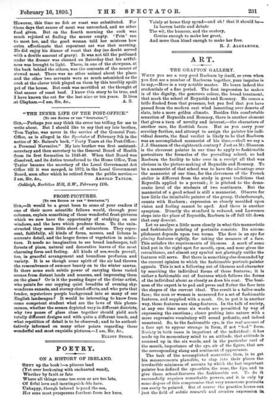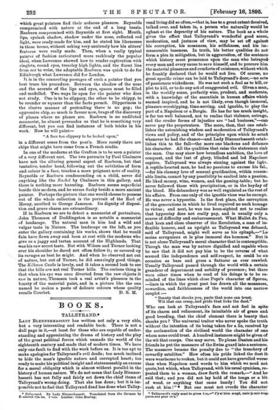ART.
THE GRAFTON GALLERY.
WHEN you see a very good Raeburn by itself, or even when you first see a number of Raeburns together, your impulse is to say,—Here is a very notable master. He bears indeed the credentials of a fine period. The first impression he makes is of the dignity, the generous colour, the broad treatment, that mark the school of Reynolds and Romney. He comes a. trifle flushed from that presence, but you feel that you have passed from the modern east wind lamenting over deserts of slate, into a more golden climate. Besides this comfortable sensation of Reynolds and Romney, there is another element that gives a turn of novelty and interest,—the characters of another race, the Scottish faces. But as you carry your scrutiny further, and attempt to assign the painter his indi- vidual deserts, the final verdict is likely to be that Raeburn was an accomplished mannerist of his time,—shall we say a 3.3. Shannon of the eighteenth century P Just as Mr. Shannon is the cleverest painter in our time to apply to fashionable portraiture the formulas of the prevailing school, so had Raeburn the facility to take over in a receipt all that was obvious in the picture-making of Reynolds and Romney. To be a mannerist of that school was to have the advantage over the mannerist of our time, for the cleverness of the French atelier is different from the study in great traditions that Reynolds applied to a portrait ; it is pitched to the demo- cratic level of the students of two continents. But the mannerist of a good school is still a mannerist. Observe for how little the inimitable painter of the group, Gainsborough, counts with Raebarn; expression so closely moulded upon vision and feeling cannot be aped. And there is another symptom. Directly the standard is reduced, and Lawrence steps into the place of Reynolds, Raeburn is off full tilt down that easy descent.
Let us analyse a little more closely in what this manneristic and fashionable painting of portraits consists. Its accom- plishment depends upon two terms. The first is an eye for placing features rightly, for taking the measure of a face. This satisfies the requirements of likeness. A mark of some kind put in the right spot for mouth, eyes, and nose gives the resemblance, and almost any symbol not glaringly unlike the features will serve. But there is something else demanded by the current opinion to which the fashionable portrait-painter appeals. This is not a following out of likeness and character by searching the individual forms of those features; it is rather a fashionable cut of features which follows the forms of the individual about as closely as does his coat. The busi- ness of the expert is to pad and press and flatter the face into the shapes of the current ideal. The result is a tailor-made face; the man or woman is measured for a set of fashionable features, and supplied with a mask. Or, to put it in another way, those features are slang-features. In the talk of society, at any one time some six words are permitted by way of expressing the emotions ; closer probing into nature with a more expressive vocabulary will sound pedantic, and indeed unnatural. So, to the fashionable eye, is the real account of a face apt to appear strange in form, if not " bad " form. Society in both cases is impatient of the individual : it has made up its momentary mind to an attitude, that attitude is summed up in the six words, and in the particular curl of the month, importance of the eye, air of the figure, that are the corresponding slang and sentiment c,f appearance. The task of the accomplished mannerist, then, is to get his measurements plausible, to clap into their places the irreducible minimum of accents by which the last important painter has defined the eye-orbits, the nose, the lips, and to give these school-features the fashionable cut. Ti do it successfully requires remarkable powers, and it is only by some degree of this compromise that very numerous portraits can easily be painted. But of course the practice leaves out just the field of subtle research and creative expression in
which great painters find their arduous pleasure. Reynolds compromised with nature at the end of a long tussle. Raeburn compromised with Reynolds at first sight. Mouth, lips, eyelash shadow, shadow under the nose, reflected red light, were ready-made for him, and he stated his likenesses in these terms, without asking very anxiously how his sitters' features were really made. Then, when a really typical painter of fashion caricatured more recklessly the popular ideal, when Lawrence showed how to render captivation with ringlets, round eyes, treacley high lights, and the fluent line from ear to wrist, the adaptable R3,ehurn was quick to do for Edinburgh what Lawrence did for London.
It is in the connecting passages of such a painter that you best trace his procedure. Between the shadow of the nose and the accents of the lips and eyes, spaces must be filled and modelled. Two ways lie open for the painter who does not study. One is to be slippery, the other to be chippy, to be rounder or squarer than the facts permit. Slipperiness is the elusive manner of pretending there is no gap; the aggressive chip, so much in favour now, brags of the discovery of planes where no planes are. Raeburn is no undiluted mannerist, he almost persuades us that he is something very different, but you can find instances of both tricks in his work. Now he will paint- " A face too slippery to be looked upon," in a different sense from the poet's. More rarely there are chips that might have come from a French studio.
In one of the moderns at the Grafton is to be seen a painter of a very different sort. The two portraits by Paul Chalmers have not the alluring general aspect of Raeburn, but that tentative, tender hand, following out the subtleties of form and colour in a face, touches a more poignant note of reality. Reynolds or Raeburn condescending on a child, never did anything like the Rachel by Chalmers in this gallery, and there is nothing more haunting. Raeburn seems superficial beside this modern, and he seems flashy beside a more ancient painter. Perhaps the picture that one would choose to possess out of the whole collection is the portrait of the Earl of Moray, ascribed to George Jameson. Its dignity of disposi- tion and grave charm are extraordinary.
If in Raeburn we are to detect a mannerist of portraiture, John Thomson of Daddingston is as notable a mannerist of landscape. The natural man in him had a wild and vulgar taste in Nature. The landscape on the left, as you enter the gallery containing his works, shows that he would fain have flown away and been at rest with the moderns who give us a jaggy and tartan account of the Highlands. That was his raw secret taste. But with Wilson and Turner looking over his shoulder he dared not often follow it ; or covered up its ravages as beat be might. And when he observed not out of nature, but out of Turner, he did amazingly good things. The Kilbaun Castle is lovely, and it takes a second look to see that the hills iia's not real Turner hills. The curious thing is that when his eye was once diverted from the raw objects it saw in nature, Thomson took a real artist's pleasure in the beauty of the material paint, and in a picture like the one named he makes a paste of delicate colours whose quality



































 Previous page
Previous page